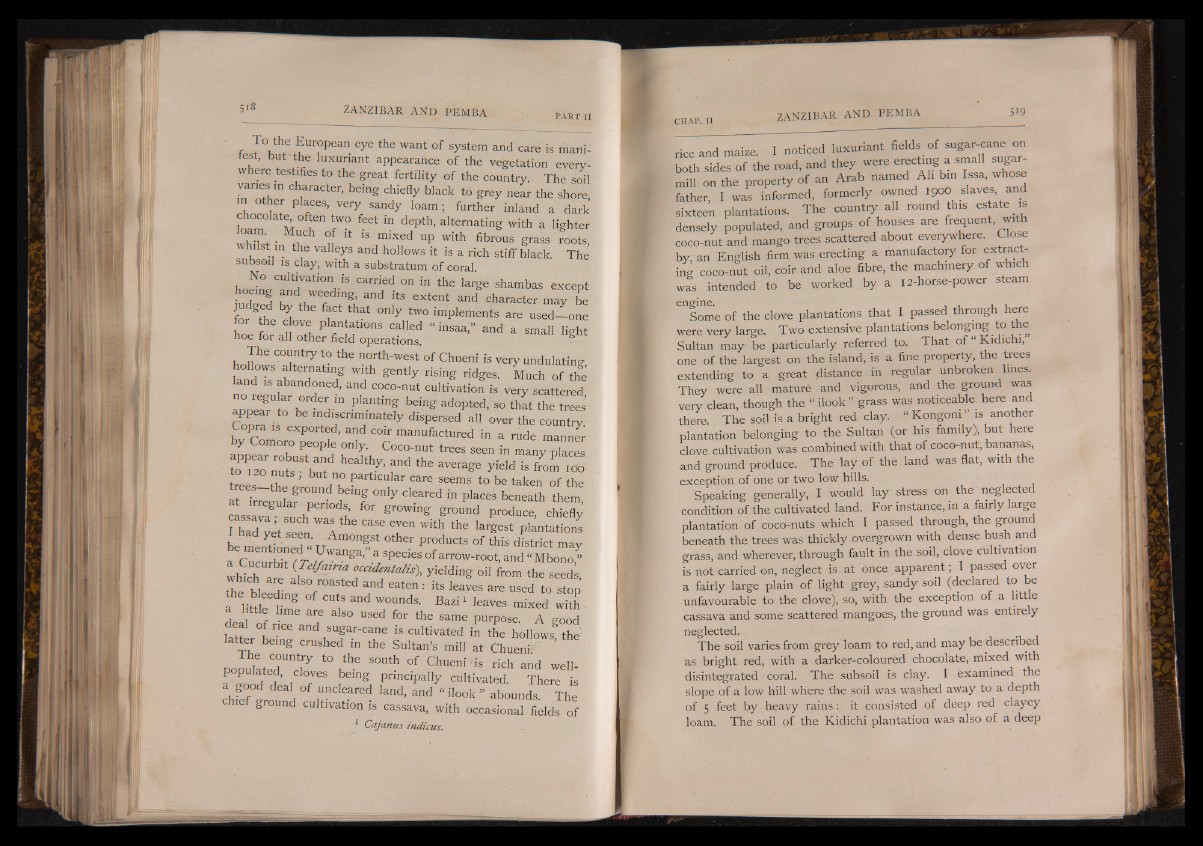
To the European eye the want of system and care is manifest,
but the luxuriant appearance of the vegetation everywhere
testifies to the great fertility of the country. The soil
¡ " 2 , “ character’ bei«g chiefly black to grey near the shore,
other places, very sandy loam; further inland a dark
L m ^ i-W° feet “ depth’ alternati«g with a lighter
wMEt * r n 11 13 mixed whilst in the valleys and hollowsU pit wisi tah rifcihb rsotuifsf bglraacsks. roTohtse,
subsoil is clay, with a substratum of coral.
^ J g ^ u ltivation fe carried on in the large shambas except
hoeing and weeding, and its extent and character may be
for^he d 6 f Ct.that °nly two implements are used— one
for the c ove plantations called “ insaa,” and a small light
hoe for all other field operations.
The country to the north-west of Chueni is very undulating
hollows alternating with gently rising ridges. Much of the
land is abandoned, and coco-nut cultivation is very scattered »¿r oT h in mpm 11 ad°pted- “ *h« «>» B appear to be indiscriminately dispersed all over the country
copra ,S exported, and coir manufactured in a rude mannTr
by Comoro people only. Coco-nut trees seen in many places
to 120 nuts , but noh epaaIrtit-iyc>u lrard c athree aseveemras^ t o be taIke n of “the
trees— the ground being only cleared in places beneath them
c a s s a S f°r g" " " ing E l Produce, chiefly'
I had y « seen A “ T T " " 'h ,he S I « « B l f had yet seen Amongst other products of this district mav
a 'Cucurbit ( ‘'pecieti ° f arrow~root> and IMbono,”
a Cucurbit {Telfairm occidental), yielding oil from the seeds
I “ ” aIs° roasted a" d «•»<*■*• leaves are K
f little CUt,S “ d WOUndS- Bazi' leaves m“ ed with ■
, , f . arf also used for the same purpose. A good
1 tt, °u nCe an sug ar“cane is cultivated in the hollows the
latter being crushed in the Sultan’s mill at C h u en i
PJopaulaStedZ, cSlov est 0Kbehien gS °pUrtihn c°ifp aCllhyU £cunil tiivSa teridG.h anTdh erwee Uis-
a good deal of uncleared land, and “ ilook ” abounds The
chief ground cultivation is cassava, with occasional fields of
1 Cajanus indicus.
rice and maize. I noticed, luxuriant fields of sugar-cane on
both sides of the road, and they were erecting a small sugar-
mill on the property of an Arab named A libm Issa- whos^
father, I was informed, formerly owned 1900 slaves and
sixteen plantations. The country all round this estate is
densely populated, and groups of houses are frequent, with
coco-nut and mango trees scattered about everywhere. Close
by, an English firm was erecting a manufactory for extracting
coco-nut oil, coir and aloe fibre, the machinery of which
was intended to be worked by a 12-horse-power steam
Some of the clove plantations that I passed through here
were very large. Two extensive plantations belonging to the
Sultan may be particularly referred to. That o f “ Kidichi,
one of the largest on the island, is a fine property, the trees
extending to a. great distance in regular unbroken lines.
They were all mature and vigorous, and the ground was
very clean, though the “ ilook ” grass was noticeable here and
there The soil is a bright red clay. “ Kongoni ” is another
plantation belonging to the Sultan (or his family), but here
clove cultivation was combined with that of coco-nut, bananas,
-and ground produce. The lay of the land was flat, with the
exception of one or two low hills.
Speaking generally, I would lay stress on the neglected
condition of the cultivated land. For instance, in a fairly large
plantation of coco-nuts which I passed through, the ground
beneath the trees was thickly overgrown with dense bush and
grass, and wherever, through fault in the soil, clove cultivation
is not carried on, neglect is at once apparent; I passed over
a fairly large plain of light grey, sandy soil (declared to be
unfavourable to the clove), so, with the exception of a little
cassava and some scattered mangoes, the ground was entirely
neglected.
The soil varies from grey loam to red, and may be described
as bright red, with a darker-coloured chocolate, mixed with
disintegrated coral. The subsoil is clay. I examined the
slope of a low hill where the soil was washed away to a depth
of 5 feet by heavy rains: it consisted of deep red clayey
loam. The soil of the Kidichi plantation was also of a deep